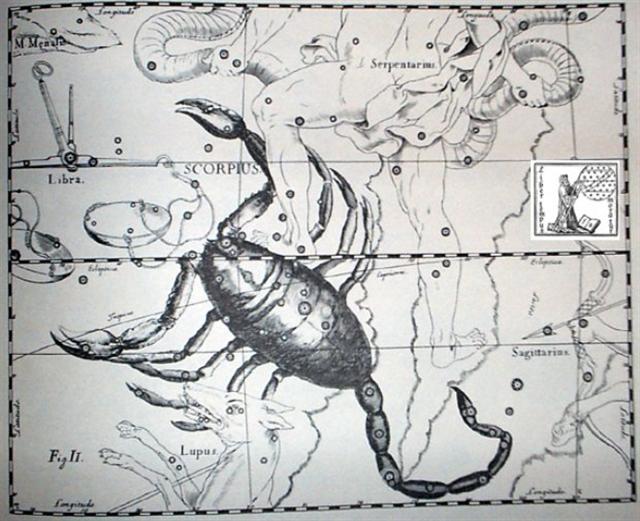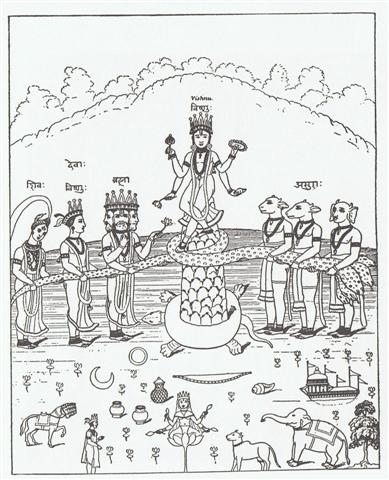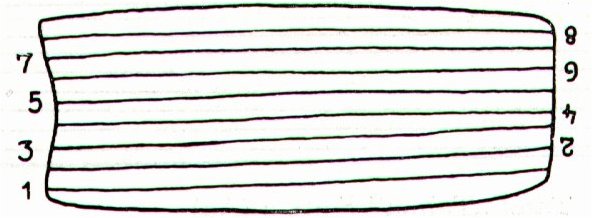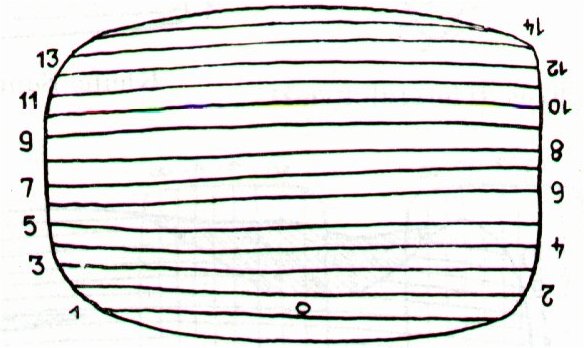It is time to 'use both our eyes', to look also at
the G text. Where, for instance, is 'the last point on Land', a
glyph corresponding to Cb8-26?
|
'October 1 |
2 |
3 |
4 (277) |
|
October 28 |
29 |
30 |
31 (304) |
 |
 |
 |
 |
|
Cb8-24 |
Cb8-25 |
Cb8-26 |
Cb8-27 (590) |
| te
maitaki |
kua hua
te kahi |
te ahine poo puo |
ki te
huaga |
|
ρ Lupi
(221.0), Toliman (221.2), π Bootis (221.8), ζ Bootis
(221.9) |
31 Bootis
(222.0), Yang Mun (222.1),
Rijl al Awwa (222.5), ο
Bootis (222.9) |
Izar
(223.0), 109 Virginis, α Apodis (223.3) |
Al
Zubānā-14a /
Visakha-16 /
Root-3 |
|
ZUBEN
ELGENUBI
(224.2), ξ Bootis, ο Lupi (224.5) |
|
ν Arietis (38.5) |
μ Arietis (39.4),
Head of the Fly (39.6),
Kaffaljidhma (39.8) |
ο Arietis (40.0), Angetenar
(40.2), Right Wing (40.9) |
Bharani-2 /
Stomach-17 |
|
π Arietis (41.2),
BHARANI (41.4), τ² Eridan,
σ Arietis (41.7) |
The form of the G tablet is rectangular and the
opposite of the rounded outline of the C tablet. This tells us
we could expect a radically different view.
Perhaps, therefore, we should search for the
Head of the Fly instead of the Foot of the Barker - the first
star of the Fly (35 Arietis) instead of the last Greek lettered star
in Virgo, stars which are half a year apart.
303
(October 30) - 183 = 120 (April 30) = 80 + 40. And 409 (Rogo
in Gb6-26) + 40 = 449:
|
'March
30 |
31 |
'April 1
(91) |
|
April 26 |
27 |
28 (118) |
 |
 |
 |
|
Gb8-3 |
Gb8-4 |
Gb8-5 |
|
no star listed (36) |
no star listed (37) |
ν Arietis (38.5) |
|
'April 2 |
3 |
4 |
5 |
|
April 29 |
30 |
May 1 (121) |
2 |
 |
 |
 |
 |
|
Gb8-6 |
Gb8-7 (*40) |
Gb8-8 (450) |
Gb8-9 |
|
μ Arietis (39.4),
Head of the Fly
(39.6),
Kaffaljidhma (39.8) |
ο Arietis (40.0), Angetenar
(40.2),
Right Wing (40.9) |
π Arietis (41.2),
BHARANI (41.4), τ² Eridan,
σ Arietis (41.7) |
no star listed (42) |
|
31 Bootis
(222.0), Yang Mun (222.1),
Rijl al Awwa (222.5), ο
Bootis (222.9) |
Izar
(223.0), 109 Virginis, α Apodis (223.3) |
ZUBEN
ELGENUBI
(224.2), ξ Bootis, ο Lupi (224.5) |
Kochab
(225.0) |
The
bird spirit (manu rere) in Gb8-5 (where 8 * 5 = 40) has turned his head around,
which is a very powerful Sign. His left wing is drawn down and likewise
his left foot. He has no future. It could be autumn.
The reversed manu rere could be at the
opposite side of the year compared to
'April 1 (in the times of Al Sharatain) or at the
opposite side of the year compared to April 28
(118) in rongorongo times. 118 = 472 / 4.
Therefore 'April 1 (91) + 183 = 274 = 'October 1
could be argued as the position of the reversed manu rere.
Possibly the 'Libra beam' across could be both at 'April 1 and
at 'October 1 - reaching out from the Sun to the Full Moon:
A 'Sun beam across'
in the times of Al Sharatain could have had a Sun measure (91 =
364 / 4), whereas the beam across in rongorong times could
have had a Moon
measure (118 = 472 / 4). 118 - 91 = 27.
... 'There is a
certain place where the scorpion with his tail and curving claws
sprawls across two signs of the zodiac', wrote Ovid in his
Metamorphoses. He was referring to the ancient Greek version
of Scorpius, which was much larger than the constellation we
know today. The Greek scorpion was in two halves: one half
contained its body and sting, while the front half comprised the
claws. The Greeks called this front half Chelae, which
means 'claws'. In the first century
BC the
Romans made the claws into a separate constellation, Libra, the
Balance.
 Perhaps G should be
read with the nakshatra Full Moon in mind and C with heliacal Sun in
mind.
In rongorongo times those 91 days in a quarter
would had grown from
the force of the precession to 118 nights. The oval form of the
C tablet could indicate its text was dealing with the precession
(a Sun phenomenon) since Roman times. The G text, on the other
hand, could deal with the star positions in rongorongo times (as
observed in the nighttime close to the Full Moon).
The Sun had to be abandoned, he no longer 'made
landfall'. Therefore it was no problem that 364 = 4 * 91 < 4 *
118 = 472. The difference 472 - 364 = 108 ought to have
secured a place in myth. However, this number originated earlier I remember
from a page in my preliminary
glyph type dictionary:
|
"...
It is known that in the final battle of the
gods, the massed legions on the side of 'order'
are the dead warriors, the 'Einherier' who once
fell in combat on earth and who have been
transferred by the Valkyries to reside with Odin
in Valhalla - a theme much rehearsed in heroic
poetry.
On
the last day, they issue forth to battle in
martial array. Says Grimnismal (23):
'Five hundred gates and forty more - are in the
mighty building of Walhalla - eight hundred
'Einherier' come out of each one gate - on the
time they go out on defence against the Wolf.'
That
makes 432,000 in all, a number of significance
from of old.
This
number must have had a very ancient meaning, for
it is also the number of syllables in the
Rigveda. But it goes back to the basic
figure 10,800, the number of stanzas in the
Rigveda (40 syllables to a stanza) which,
together with 108, occurs insistently in Indian
tradition, 10,800 is also the number which has
been given by Heraclitus for the duration of the
Aiōn, according to Censorinus (De die natali,
18), whereas Berossos made the Babylonian Great
Year to last 432,000 years. Again, 10,800 is the
number of bricks of the Indian fire-altar
(Agnicayana).32
32
See J. Filliozat, 'L'Indie et les échanges
scientifiques dans l'antiquité', Cahiers
d'histoire mondiale 1 (1953), pp. 358f.
'To
quibble away such a coincidence', remarks
Schröder, 'or to ascribe it to chance, is in my
opinion to drive skepticism beyond its limits.'33
33 F.
R. Schröder, Altgermanischer Kulturprobleme
(1929), pp. 80f.
Shall
one add Angkor to the list? It has five gates,
and to each of them leads a road, bridging over
that water ditch which surrounds the whole
place. Each of these roads is bordered by a row
of huge stone figures, 108 per avenue, 54 on
each side, altogether 540 statues of Deva and
Asura, and each row carries a huge Naga serpent
with nine heads. Only, they do not 'carry' that
serpent, they are shown to 'pull' it, which
indicates that these 540 statues are churning
the Milky Ocean, represented (poorly, indeed) by
the water ditch,34 using Mount
Mandara as a churning staff, and Vasuki, the
prince of the Nagas, as their drilling rope.
34 R.
von Heine-Geldern, 'Weltbild und Bauform in
Südostasien', in Wiener Beiträge zur Kunst- und
Kulturgeschichte 4 (1910), p. 15.
(Just
to prevent misunderstanding: Vasuki had been
asked before, and had agreeably consented, and
so had Vishnu's tortoise avatar, who was going
to serve as the fixed base for that
'incomparably mighty churn', and even the Milky
Ocean itself had made it clear that it was
willing to be churned.)

The 'incomparably
mighty churn' of the Sea of Milk, as described
in the Mahabharata and Ramayana. The heads of
the deities on the right are the Asura, with
unmistakable 'Typhonian' characteristics. They
stand for the same power as the Titans, the
Turanians, and the people of Untamo, is short,
the 'family' of the bad uncle, among whom Seth
is the oldest representative, pitted against
Horus, the avenger of his father Osiris.

The
simplified version of the Amritamanthana (or
Churning of the Milky Ocean) still shows Mount
Mandara used as a pivot or churning stick,
resting on the tortoise. And here, also, the
head on the right has 'Typhonian' features.
The
whole of Angkor thus turns out to be a colossal
model set up for 'alternative motion' with true
Hindu fantasy and incongruousness to counter the
idea of a continuous one-way Precession from
west to east." (Hamlet's Mill) |
|






